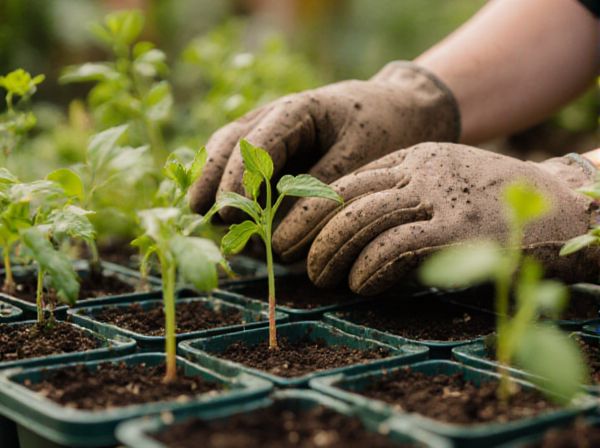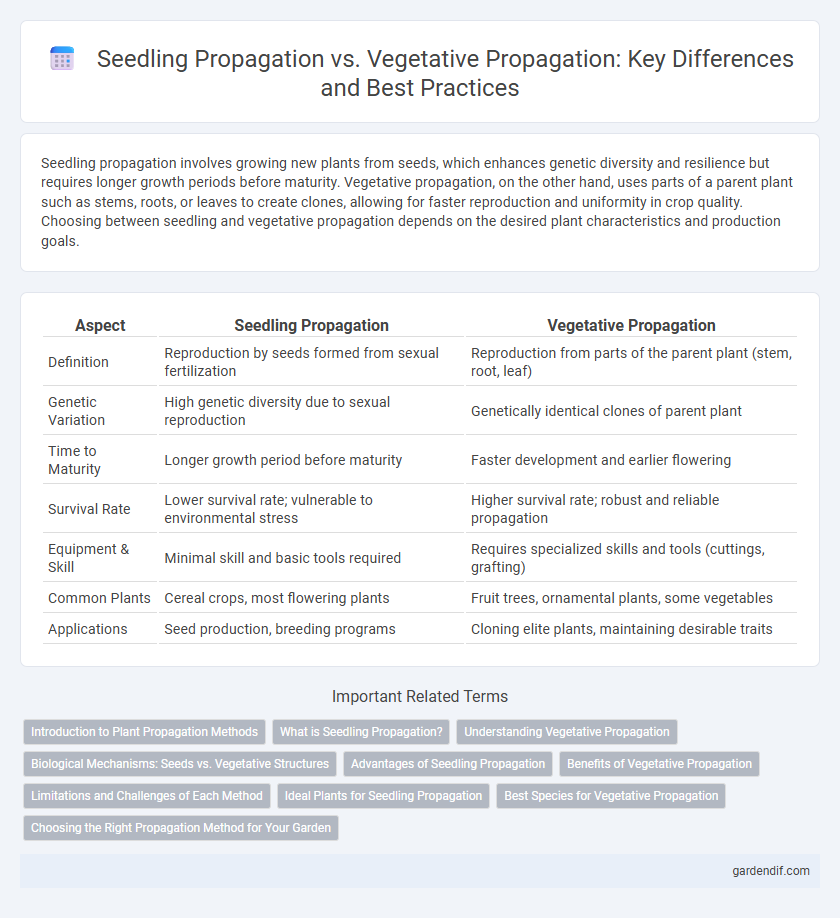
Seedling Propagation vs Vegetative Propagation Illustration
Seedling propagation involves growing new plants from seeds, which enhances genetic diversity and resilience but requires longer growth periods before maturity. Vegetative propagation, on the other hand, uses parts of a parent plant such as stems, roots, or leaves to create clones, allowing for faster reproduction and uniformity in crop quality. Choosing between seedling and vegetative propagation depends on the desired plant characteristics and production goals.
Table of Comparison
| Aspect | Seedling Propagation | Vegetative Propagation |
|---|---|---|
| Definition | Reproduction by seeds formed from sexual fertilization | Reproduction from parts of the parent plant (stem, root, leaf) |
| Genetic Variation | High genetic diversity due to sexual reproduction | Genetically identical clones of parent plant |
| Time to Maturity | Longer growth period before maturity | Faster development and earlier flowering |
| Survival Rate | Lower survival rate; vulnerable to environmental stress | Higher survival rate; robust and reliable propagation |
| Equipment & Skill | Minimal skill and basic tools required | Requires specialized skills and tools (cuttings, grafting) |
| Common Plants | Cereal crops, most flowering plants | Fruit trees, ornamental plants, some vegetables |
| Applications | Seed production, breeding programs | Cloning elite plants, maintaining desirable traits |
Introduction to Plant Propagation Methods
Seedling propagation involves growing new plants from seeds, ensuring genetic diversity and adaptability, while vegetative propagation uses plant parts such as stems, roots, or leaves to create clones of the parent plant, preserving desirable traits. These propagation methods differ in growth speed, genetic variation, and disease resistance, influencing their suitability for various horticultural applications. Mastery of both techniques enhances agricultural productivity and plant breeding efficiency.
What is Seedling Propagation?
Seedling propagation is a reproductive method in horticulture where new plants grow from seeds, enabling genetic variation and adaptation. It involves sowing seeds under controlled conditions to produce young plants that develop true to species. This method contrasts with vegetative propagation, which relies on cloning from parent plant tissues, resulting in genetically identical offspring.
Understanding Vegetative Propagation
Vegetative propagation involves producing new plants from the parts of a parent plant, such as stems, roots, or leaves, ensuring genetic uniformity and faster growth compared to seedling propagation. This method bypasses the seed germination phase, allowing plants like potatoes, strawberries, and spider plants to reproduce efficiently through runners, tubers, or cuttings. Understanding vegetative propagation is essential for horticulture and agriculture, as it enables the maintenance of desirable plant traits and enhances crop productivity.
Biological Mechanisms: Seeds vs. Vegetative Structures
Seedling propagation relies on sexual reproduction, where seeds develop from the fertilization of ovules, combining genetic material from two parent plants to enhance genetic diversity. In contrast, vegetative propagation involves asexual reproduction through vegetative structures such as stems, roots, or leaves, producing genetically identical clones of the parent plant by mitotic cell division. These biological mechanisms influence growth rates, adaptability, and propagation success, with seedlings often exhibiting greater genetic variation and vegetative methods ensuring rapid and uniform plant production.
Advantages of Seedling Propagation
Seedling propagation promotes genetic diversity, enhancing plant resilience and adaptability to environmental changes. It allows for the production of large numbers of plants at a relatively low cost compared to vegetative propagation. Seedlings typically develop stronger root systems, improving nutrient uptake and overall plant health.
Benefits of Vegetative Propagation
Vegetative propagation offers the benefit of producing genetically identical plants, ensuring uniformity and preservation of desirable traits such as disease resistance or fruit quality. This method enables faster maturation and fruiting compared to seedling propagation, as the new plants are clones of mature parent specimens. Moreover, vegetative propagation allows the reproduction of plants that do not produce viable seeds, expanding cultivation options for many species.
Limitations and Challenges of Each Method
Seedling propagation faces challenges such as genetic variability and slower growth rates, which can affect uniformity and crop predictability. Vegetative propagation, while ensuring genetic consistency, is limited by susceptibility to disease transmission and often requires more labor-intensive techniques and initial plant material. Both methods present constraints regarding scalability and environmental adaptability depending on the plant species involved.
Ideal Plants for Seedling Propagation
Seedling propagation is ideal for plants with high genetic variability and strong seed viability, such as tomatoes, peppers, and many annual flowers, which benefit from sexual reproduction to promote genetic diversity. This method suits species that produce abundant, resilient seeds capable of germinating under controlled conditions, ensuring healthy, vigorous seedlings. Seedling propagation also favors plants that can recover vigor and adapt to environmental changes better than clones produced through vegetative propagation.
Best Species for Vegetative Propagation
Vegetative propagation is highly effective for species such as potatoes, sugarcane, and strawberries due to their ability to regenerate complete plants from stems, roots, or leaves. These species exhibit superior genetic uniformity and faster growth rates compared to seedling propagation, which is ideal for maintaining desirable traits in horticulture and agriculture. Additionally, willow, ivy, and banana are also prominent candidates for vegetative propagation because of their robust regenerative capacities and adaptability.
Choosing the Right Propagation Method for Your Garden
Seedling propagation promotes genetic diversity by growing plants from seeds, ideal for species that adapt well to varying conditions, while vegetative propagation ensures uniformity through cuttings or runners, maintaining desired traits. Selecting the right propagation method depends on your garden's goals, such as whether you prioritize plant variation or consistent crop quality. Understanding plant species' compatibility with each method and environmental factors like soil type and climate is essential for successful propagation outcomes.
Seedling Propagation vs Vegetative Propagation Infographic

 gardendif.com
gardendif.com